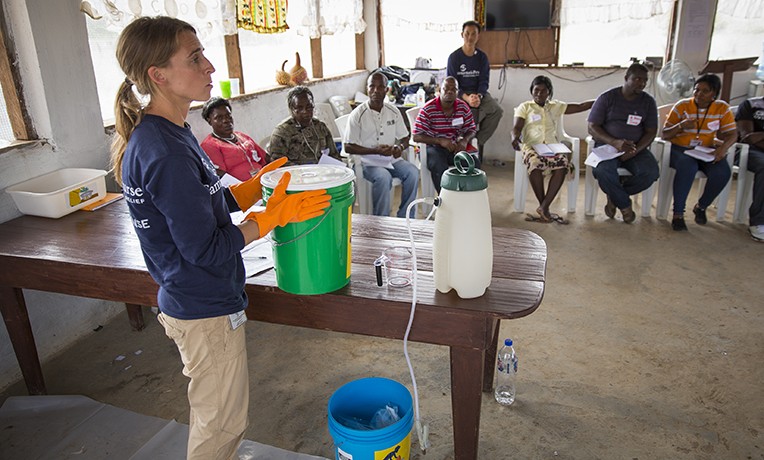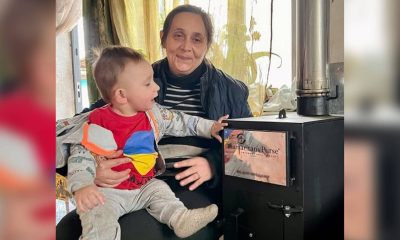Samaritan's Purse continues to work in Liberia even as the spread of the deadly disease appears to be slowing
Though news about Ebola Virus Disease (EVD) may no longer be grabbing the media’s top headlines, Samaritan’s Purse continues its full-on response to the deadly disease in Liberia.
The following Q & A, developed with Liberia staff both at our international headquarters and in the field, offers an update and insights on the current status of the outbreak.
Please continue to pray for our staff, for an end to the outbreak, and for the people of Liberia and the rest of West Africa.
How many people have died from EVD?
As of February 3, the World Health Organization reported a total of 8,959 deaths since the beginning of the outbreak in the countries of Liberia, Guinea, and Sierra Leone. The total number of reported cases stood at 22,444. The highest number of deaths has occurred in Liberia, with 3,739.
How many people are currently infected with EVD?

Liberians form a queue to receive Infection Prevention and Control kits from Samaritan’s Purse.
In late January, the weekly number of new reported cases between Guinea, Sierra Leone, and Liberia dipped below 100 for the first time since June 2014. There were only four new cases reported in Liberia that week (Jan. 18–24). There were a few dozen new cases reported in both Guinea and Sierra Leone.
In the past 21 days (as of Jan. 28 reporting), there were a total of 478 new cases counted between the three countries.
Last fall, some predicted that without interventions there could be 500,000 to more than 1 million cases of Ebola in West Africa in January 2015. By God’s grace, that’s not the case. What happened?
Focused on Liberia, there are multiple factors. As fear of EVD spread during the summer, governments, including the United States, were pressured to act. To an extent, they came through. More Ebola treatment units were constructed and better monitoring has occurred.

Samaritan’s Purse staff continues to educate Liberians about the facts on Ebola.
Probably most significantly, the attitudes and actions of the Liberian people began to change. In order to survive the outbreak, certain cultural practices (specifically regarding burials) were relinquished. People came to acknowledge Ebola is real and began to deal with it.
Samaritan’s Purse played a huge role in that success. Following two airlifts of materials, we constructed two community care centers and a transit center. More than 30,000 infection prevention and control (IPC) kits—which include a bucket with a spigot, gloves, soap, and disinfectant— have been distributed. In addition, over 1.5 million Liberians received critical EVD education through our programming. (The country has a total population of around 4.5 million.) This education likely saved countless lives.
Is the outbreak almost over?
The general thinking is that the outbreak may be declared over in Liberia in the next couple of months. However, that is likely not true for Sierra Leone and Guinea. The bottom line is that no one is sure. EVD can spike at any time; it only takes one infected person to spread the disease.
Are there reasons to be concerned about a spike in infections in Liberia?
It is not yet time to celebrate the end of this Ebola outbreak in Liberia. There are several concerns.

Handwashing is a critical defense in the fight against Ebola. Samaritan’s Purse has distributed nearly 30,000 IPC kits with buckets like this one.
–The borders with Sierra Leone and Guinea are porous and the outbreak is not as contained there. Infected people can still, in theory at least, move about.
–More than 5,000 schools are scheduled to open in February. That sounds like a good thing, until one considers that at least half of the schools have no legitimate water source or sanitation facilities. The Liberian government and UNICEF are attempting to provide guidelines and basic hygiene materials, but countrywide implementation is a work in progress.
–There is uncertainty regarding whether now-healthy Ebola survivors—those who have been treated and declared virus-free— can spread the disease via sexual contact. The World Health Organization has indicated there could some risk for the first three months or so after initial infection.
–It is possible, though not probable, that there are still hidden cases deep in the bush.
If there is a spike, will the disease spin out of control again in Liberia?
Because of international focus and involvement—including research, the building of care centers, contact tracing, the training of healthcare workers, hygiene kit distribution, and the education of millions of Liberians about EVD—it is not likely that the virus will again rampage through Liberia with such deadly force.
When will Samaritan’s Purse return to full-scale, post-Ebola operations in Liberia?

Staff members pray during the opening of the Foya Transit Center on January 26. Constructed by Samaritan’s Purse, the center can isolate and treat patients suspected of having EVD. If patients test positive, they can be transferred to an Ebola Treatment Unit; if they test negative, they can be transferred to a standard health facility or discharged. Located in Lofa County, which borders both Sierra Leone and Guinea, this is a strategic area in the fight to end EVD.
We have both international and local field staff at work in Liberia right now. Ebola prevention and education measures continue, often in partnership with local churches. Since March 2014, the Gospel has been presented more than 50,000 times through our work. Nearly 1,200 people have made a profession of faith and received subsequent discipleship.
We are also actively working toward resuming certain programs in the sectors of maternal/child health and orphaned/vulnerable children. Decisions on our post-Ebola work will be made based on field circumstances over the next weeks and months.
Samaritan’s Purse has had a major presence in Liberia for over a decade and is committed to offering physical and spiritual relief to help communities heal after this devastating outbreak. Please pray for continued opportunities to share the truth of the Gospel of Jesus Christ with people all over the country.
Can EVD be eradicated?
The Ebola virus lives in animals native to West Africa and other parts of sub-Saharan Africa, including Democratic Republic of Congo and South Sudan. Fruit bats are a likely host. People eat or touch bats or other animals infected by the bats, and thus the virus is introduced into the human population. This can happen at any time.
A vaccine, developed by GlaxoSmithKline and the U.S. National Institutes of Health, is being tested.





